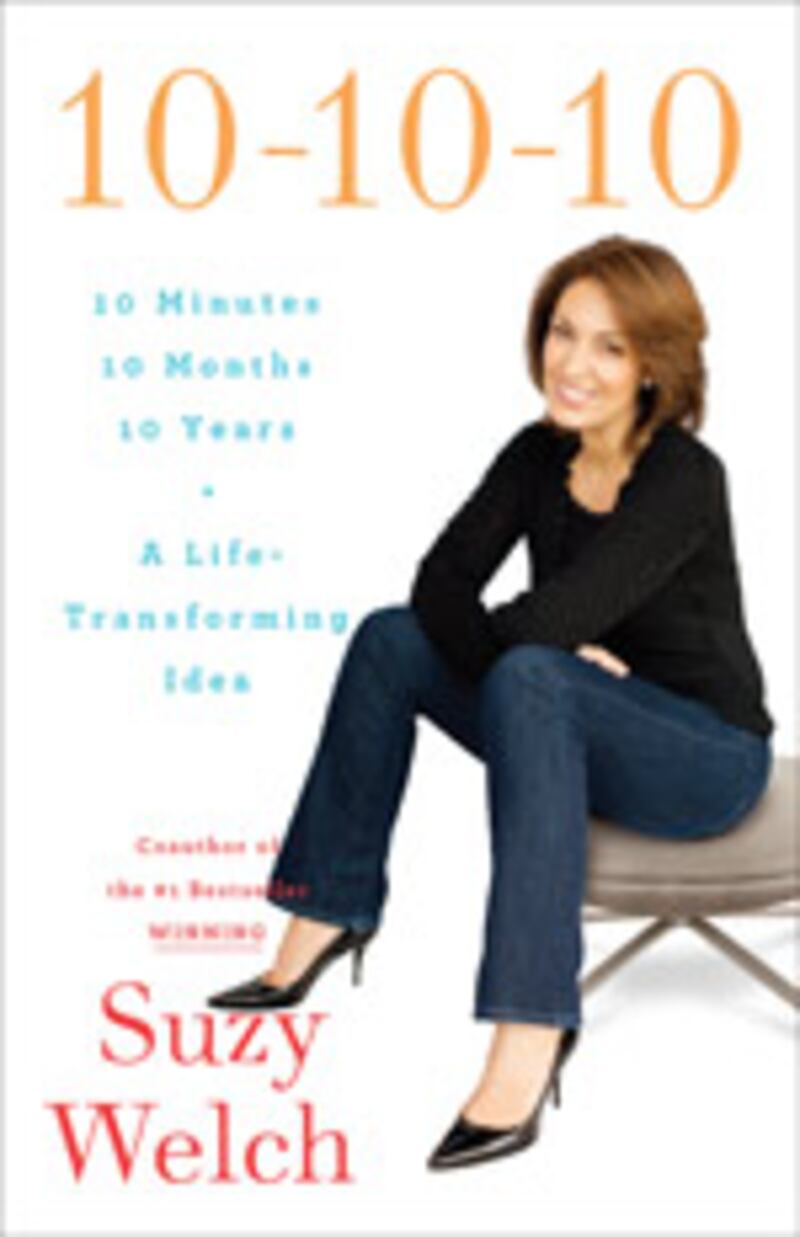
You’ve now been in touch with so many women, and you’ve been emailed and called. What are the most common things that women write to you about? That you say you can use 10-10-10 for?
10-10-10 often helps women who are at a crossroads, and the crossroads can be career and relationship, career and children, children and marriage, children and parents—that’s a great story in the book, actually marriage and parents, where there’s a woman that’s in a happy marriage, and the marriage starts falling apart because the mother’s in a nursing home. She’s torn between the time she spends with her mom, and so what happens is there are a lot of constituents in every woman’s life. There are her children, her spouse, her parents, her boss, her employees—
“It’s much easier to get to the 10-10-10 solution than it is to execute it. Because sometimes, to execute a 10-10-10, you have to come clean with a lot of people about what your true values are.”
And I think Michelle Obama kind of recognizes that. That’s why she’s talking about juggling so much—it’s that women are ripped apart all the time. And they really are the most stressed-out warriors in our community.
It’s a far beat for me to quote Britney Spears, but Britney Spears says “you want a piece of me.” And every woman has this feeling one day where everyone wants a piece of her. Your kids want a piece of you, your employees want a piece of you, and they all need you. And you know what, as women we tend to have a dynamic where we want to make everyone happy. And what happens is, everyone is happy but you. And I name it in the book, the “Everbody’s Happy But Me” syndrome, and you think, “OK, perfect life, everyone’s happy—but me,” and that’s where 10-10-10 comes in, because you have to preserve that piece of you where you are living the life you want to, or none of it works.
Do you think of this as a more useful tool for women than men? Women are far more torn asunder.
It’s rare to find a man that thinks "everybody’s happy but me," but I think that it does happen. There are men in the book—

Does Jack use it?
He does use it. In fact, the other day when we were struggling with this decision about [my daughter] Sophia, he said, “Let's 10-10-10 it.” And we got on the phone, the three of us. He loves using it with the kids, because for him, this experience of raising my kids with me has been such a revelation. He wasn’t really around to raise his own four children, who are wonderful people and parents on their own now. He wasn’t around—he was building this big career. So now, he’s getting this second chance at doing it right, and he loves the fact that he whip out this tool where at the end, we’re all happy with the decision.
It’s actually brilliant to use with kids, as a matter of fact. I think my son would love it, because he needs structure.
It’s a great framework, because you don’t diverge. You stay on these talking points: “OK, what do we want,” and it surfaces where your assumptions, expectations, and values diverge, and come together.
Is it going to be a useful tool if you don’t have your values sorted out in the first place? Because it seems to me that, in a way, it’s great at surfacing the values if you have them. There was that very good piece in the book about that woman who wanted to keep traveling, and the husband wanted her to stay with the baby. To me, I thought, “You’re just a selfish person anyway.”
That was a case where they were living on values that weren’t explicitly stated. And the hardest part of the book is that chapter on values, where the book walks you through your paces, identifying yours. I mean, I was a thirtysomething-year-old when I said, “OK, I actually have values that are not generic and I need to identify them.”
Well how do you reconcile drives and values? Because, as we know, a lot of the women’s movement over the last 30 years has been about acknowledging and satisfying your drives. So, sometimes the drives are really at odds with the values.
You can’t separate them, or else you’re lying to yourself. If your drive is to work all the time, and you say, "Well, my value is to be home with my children," it’s B.S. Your value is to be working if you’re working, and you have to come clean with yourself. One of the most liberating things you can say—at least for me it was—is, “I love my work. I will work. I’m not going to try to lie to you kids, I’m much happier when I’m working, I’m a better mother to you when I’m working, and even if I was a worse mother, I can’t live without working. And so, I could have given all the lip-service in the world to balance, and being a great mom, but I had to come clean with everybody, saying this is where work comes in my life. And it’s going to have consequences. It’s going to mean I’m not at every swim meet. You make up for it in different ways, and you become a different kind of mother.
When your kids talk to you about it now, how do they feel about the balance you’ve struck?
I am very, very lucky in that my kids are—somebody asked me the other day, why are your kids so in love with you? I don’t know the answer to that, except for maybe they saw me struggle so hard. Or maybe because I love them so passionately. Or maybe because I got really lucky. You know, they come out their own little people, with their own little surprises for you. I was always sort of radically candid with them. I think they had a lot of trust for me because I never tried to sugar-coat it. And it worked.
I think they do sense that absolute deep love. It is really tough, though, that negotiation with yourself. Because there really are times when, as you rightly describe in your book, a very good scene when you’re asked to go to that conference, and it’s going to be conflicting with your kids. And we’ve all said—I’ve said, particularly at The New Yorker, when my kids were younger, and you’ve actually said, as part of your negotiation with your kids: Don’t worry, I’m going to be home tomorrow night. We’re going to do something special. We’re going to curl up together and watch TV, and I’m going to look at your project, and that’s what we’ll do—as compensation for the last time you didn’t do it. And then, if something comes up that’s brutal at work, and you’re in such agony, and it’s such a conflict, and you feel you’re failing on every front, I think it happens just every day for every woman.
Right. Like I say in the book, whether you use 10-10-10 or not, being a working mother for a certain period of time, especially when the kids are young, and they’re not yet able to pay it forward, is one little series of agonies after another. Nothing is going to make that go away. When you love your work and you love your kids at the same time, it is a very difficult period. And women have to negotiate it the best way they can. There is no solution to how hard it is. But there are policies that make it easier, and more transparent. So you can say to your kids, “Look, I made this decision because of X, Y, and Z, take it or leave it. But I happen to be the parent. When you raise your own kids, do it your own way.”
Have you had resistance to the idea? Because what I do like very much about the book is that you do give women permission to own up to the things that are important to them. And a lot of the Mommy Wars have been about it being either/or. It’s horrible having to have this conflict with your kids. The kids always win, if you’re a good mother. And if they don’t, you’re a bad mother.
Right. After I got divorced and I needed to be at work, it was a lot easier to talk about work with my kids. But before that, when I didn’t have to be at work, I had to say to them, it’s a choice. The push-backs I get, in general, you know, generally people sort of are saying, “I get it, it allows me to talk about my own priorities.” Women who say, “Wait, isn’t the decision always what’s best for the kids?" And I say, actually, if that’s your value—what the kids want and need always should come first, by all means, make your decisions according to that value.
Most women will say that probably. There are some women who will say, “They had a right to express how they felt, the guy was the interloper,” and he should have put up with it.
And they have a right to that feeling, but my feeling is that children under 12 don’t decide how families should operate. That’s my personal belief and my value system. I believe kids should have some agency, and some ability to make choices, but on a choice about what a family is going to look like, I’m sorry, they haven’t had the wisdom yet to make that decision. Kids have strong emotions, but they’re kids! And I was the adult, and I was going to own the consequences of the decision, and I was accountable for those children, and I was going to make the decision, not them.
And the other push-back is from Christians, who say, wait a minute—isn’t what God wants always the way you should go? And I write about in the book, about how I was taken aback by somebody at a Q&A saying, “I don’t get it. Can you be a Christian and use this?” And, wonderfully, I found a Christian minister who preaches 10-10-10 in Canada, at one of the big mega-churches up there. And he said, I think it enables Christians, because, you know, once again, your voices. Your values, are, to say, to live Biblically. And then you can say, "In 10 minutes, what would Jesus have me do, and in 10 months, what would Jesus have me do," and you just take your set of values, and you use the process. But what you’ve got is a process.
Is there any outstanding problem that you’ve been faced with on 10-10-10 that was really interesting to resolve?
You mean a 10-10-10 I couldn’t crack?
Or a 10-10-10 you got to crack, but that it was hard getting there.
You know, it’s much easier to get to the 10-10-10 solution than it is to execute it. So what typically happens is that you get to it with somebody. People come to you with very painful, complicated dilemmas. You work it through. Sometimes I’m on the phone with them an hour, or I’m with them a day, or I’m with them for 10 minutes, or they email me and I email them back. And we can pretty much—once the priorities are sorted out—we can invariably come to it. The gap, and the pain, is in executing it. Because sometimes, to execute a 10-10-10, you have to come clean with a lot of people about what your true values are. And to make that leap, and to turn to a husband and say, “I have been living a lie with you for the past 10 years, and you’ve been living a lie with me, and we’ve not faced that lie.” I mean, there’s a story in the book where a couple, Jillian and Mike, who I was made aware of through a marriage counselor who uses 10-10-10, where they’re sitting in marriage counseling—she wants to save the marriage, he doesn’t. They’re talking about their values, and she lists the marriage as one of her values, and he looks at her and says, "Jill, there’s no marriage.”
So, sometimes 10-10-10 forces you to start talking about what you’ve not talked about.
Unless you can be candid.
That’s a big unless.
And are your kids using it on their own lives now?
The girls are. The boys, when I use it with them, I’m not sure my 20-year-old, college-age fraternity-bound son is using it. But I wish.
I was quite interested in what you said about your [fourth] child. What you said about when you were pregnant with Eve, and you decided to stay in the marriage—tell me about that.
The marriage was in a bad place, but we kept sort of bringing it back from the brink. And while it was in a bad place, I got pregnant. And, I remember thinking, “Oh my God. What have I done?” Knowing that the marriage was going to end someday. And then I thought, “Well, I have to postpone it. I have to postpone the ending of the marriage.” And I’m sure my ex-husband thought the same thing at the same time, which is, “We have to postpone this again.”
Are you on good terms now?
Yeah. I am on good terms with him. I mean, we’ve both gone on to have the lives we were meant to have. He’s remarried, he has two new children, and you know, our primary emotion at our divorce, I think, was relief. There are people who have different emotions—for both of us, I think, it was relief.
I’ve got several friends going through divorces, and I really think this is going to be very helpful to them, because it allows them to be honest with themselves, because there’s so much guilt involved.
Guilt is how we make so many of our decisions. I always say that 10-10-10 switches you from making guilt-driven decisions to value-driven decisions. And I mean, when you think about it, what is guilt? Why are we so beholden to it? Why can’t we open it up and unpick it, understand it for what it is. Guilt and momentum are the two most negative driving forces in decision-making.
Tina Brown is the founder and editor in chief of The Daily Beast. She is the author of the 2007 New York Times best seller The Diana Chronicles. Brown is the former editor of Tatler, Vanity Fair, The New Yorker, and Talk magazines and host of CNBC's Topic A with Tina Brown.






